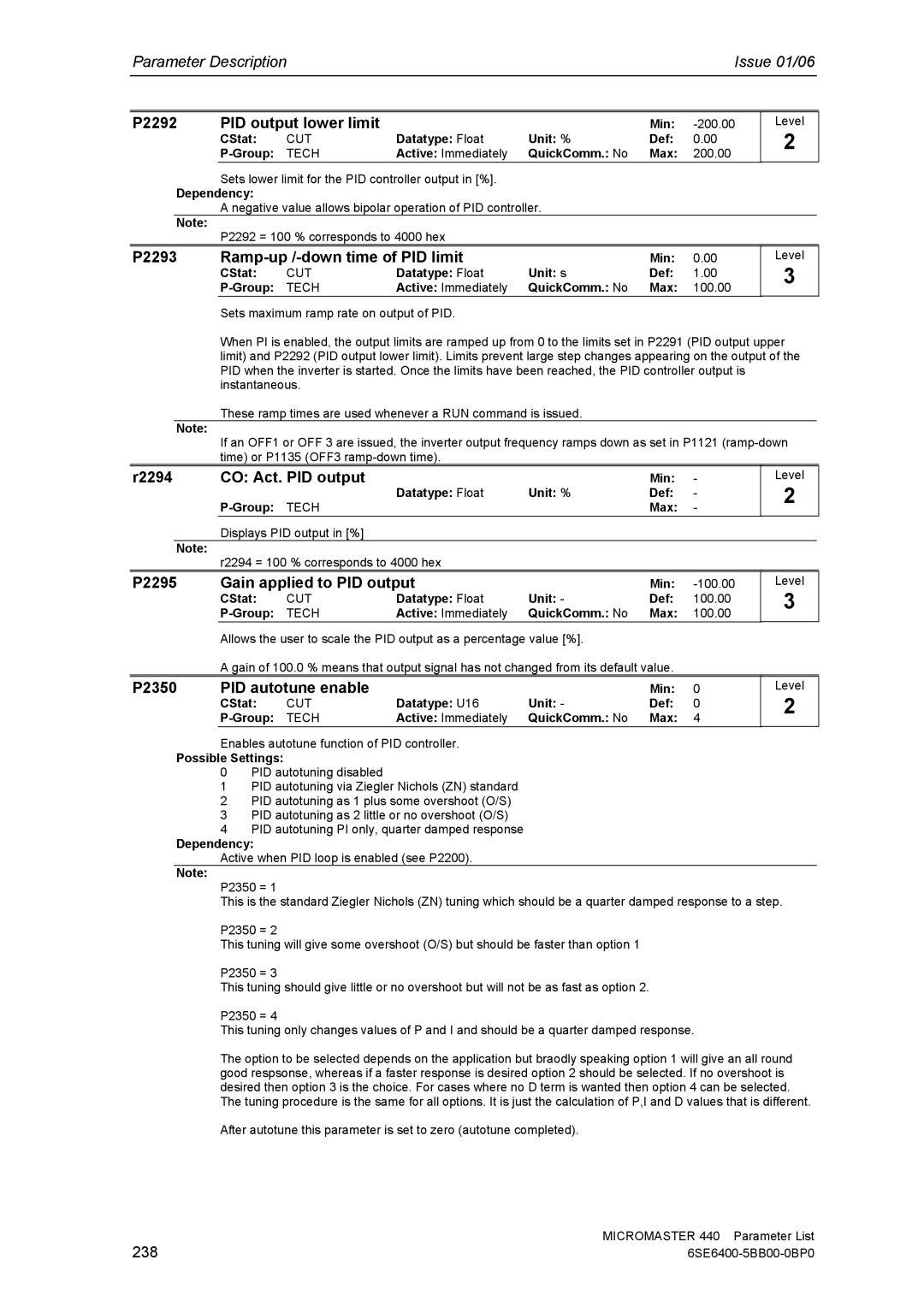
Parameter Description | Issue 01/06 |
P2292 | PID output lower limit |
|
| Min: | ||
| CStat: | CUT | Datatype: Float | Unit: % | Def: | 0.00 |
| TECH | Active: Immediately | QuickComm.: No | Max: | 200.00 | |
Level
2
Sets lower limit for the PID controller output in [%].
Dependency:
A negative value allows bipolar operation of PID controller.
Note:
P2292 = 100 % corresponds to 4000 hex
P2293 |
|
| Min: | 0.00 | ||
| CStat: | CUT | Datatype: Float | Unit: s | Def: | 1.00 |
| TECH | Active: Immediately | QuickComm.: No | Max: | 100.00 | |
Sets maximum ramp rate on output of PID.
Level
3
When PI is enabled, the output limits are ramped up from 0 to the limits set in P2291 (PID output upper limit) and P2292 (PID output lower limit). Limits prevent large step changes appearing on the output of the PID when the inverter is started. Once the limits have been reached, the PID controller output is instantaneous.
These ramp times are used whenever a RUN command is issued.
Note:
If an OFF1 or OFF 3 are issued, the inverter output frequency ramps down as set in P1121
r2294 | CO: Act. PID output |
| Min: | - | Level |
| Datatype: Float | Unit: % | Def: | - | 2 |
|
| ||||
|
| Max: | - |
|
Displays PID output in [%]
Note:
r2294 = 100 % corresponds to 4000 hex
P2295 | Gain applied to PID output |
| Min: | |||
| CStat: | CUT | Datatype: Float | Unit: - | Def: | 100.00 |
| TECH | Active: Immediately | QuickComm.: No | Max: | 100.00 | |
Allows the user to scale the PID output as a percentage value [%].
Level
3
A gain of 100.0 % means that output signal has not changed from its default value.
P2350 | PID autotune enable |
|
| Min: | 0 | |
| CStat: | CUT | Datatype: U16 | Unit: - | Def: | 0 |
| TECH | Active: Immediately | QuickComm.: No | Max: | 4 | |
Level
2
Enables autotune function of PID controller.
Possible Settings:
0PID autotuning disabled
1PID autotuning via Ziegler Nichols (ZN) standard
2PID autotuning as 1 plus some overshoot (O/S)
3PID autotuning as 2 little or no overshoot (O/S)
4PID autotuning PI only, quarter damped response
Dependency:
Active when PID loop is enabled (see P2200).
Note:
P2350 = 1
This is the standard Ziegler Nichols (ZN) tuning which should be a quarter damped response to a step.
P2350 = 2
This tuning will give some overshoot (O/S) but should be faster than option 1
P2350 = 3
This tuning should give little or no overshoot but will not be as fast as option 2.
P2350 = 4
This tuning only changes values of P and I and should be a quarter damped response.
The option to be selected depends on the application but braodly speaking option 1 will give an all round good respsonse, whereas if a faster response is desired option 2 should be selected. If no overshoot is desired then option 3 is the choice. For cases where no D term is wanted then option 4 can be selected. The tuning procedure is the same for all options. It is just the calculation of P,I and D values that is different.
After autotune this parameter is set to zero (autotune completed).
238 | MICROMASTER 440 Parameter List |
